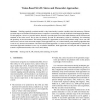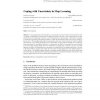161 search results - page 29 / 33 » Using EM to Learn 3D Models of Indoor Environments with Mobi... |
IJCV
2007
13 years 7 months ago
2007
Building a spatially consistent model is a key functionality to endow a mobile robot with autonomy. Without an initial map or an absolute localization means, it requires to concurr...
ESSMAC
2003
Springer
14 years 18 days ago
2003
Springer
We apply a constrained Hidden Markov Model architecture to the problem of simultaneous localization and surveying from sensor logs of mobile agents navigating in unknown environmen...
ICRA
2003
IEEE
14 years 20 days ago
2003
IEEE
— As people move through their environments, they do not move randomly. Instead, they are often engaged in typical motion patterns, related to specific locations they might be i...
IJCAI
1989
13 years 8 months ago
1989
In many applications in mobile robotics, it is important for a robot to explore its environment in order to construct a representation of space useful for guiding movement. We refe...
ICIP
2007
IEEE
14 years 9 months ago
2007
IEEE
Interest point detectors are the starting point in image analysis for depth estimation using epipolar geometry and camera ego-motion estimation. With several detectors defined in ...


